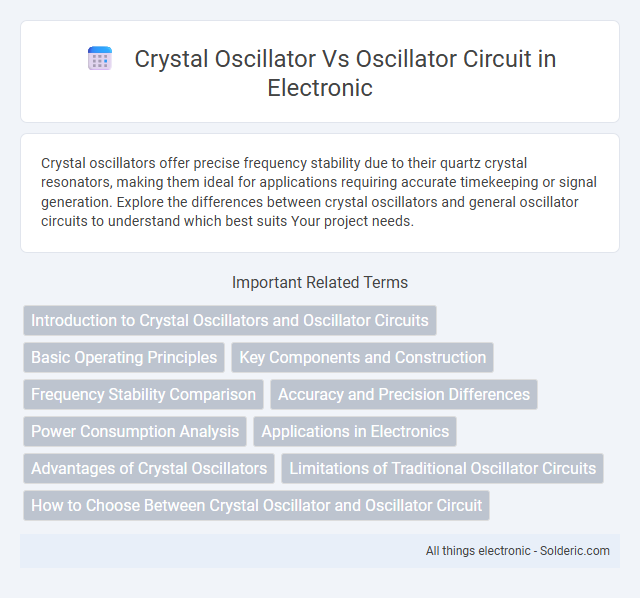Crystal oscillators offer precise frequency stability due to their quartz crystal resonators, making them ideal for applications requiring accurate timekeeping or signal generation. Explore the differences between crystal oscillators and general oscillator circuits to understand which best suits Your project needs.
Comparison Table
| Feature | Crystal Oscillator | Oscillator Circuit |
|---|---|---|
| Definition | Oscillator using quartz crystal for frequency control. | Electronic circuit generating repetitive signals without crystal. |
| Frequency Stability | High stability (+-10 ppm or better). | Lower stability, varies with components and temperature. |
| Frequency Accuracy | Very accurate, set by crystal's mechanical resonance. | Less accurate, depends on component tolerances. |
| Frequency Range | Typically 32 kHz to 100 MHz. | Wide range, depending on design and components. |
| Output Waveform | Usually sine wave or clipped sine wave. | Can be sine, square, triangle, or sawtooth. |
| Applications | Clocks, radios, microcontrollers, communication devices. | Signal generators, timers, RF circuits, audio devices. |
| Cost | Higher due to crystal component. | Generally lower cost. |
| Size | Small, crystal adds minimal size. | Varies, depends on circuit complexity. |
| Power Consumption | Low power consumption. | Varies, can be higher. |
Introduction to Crystal Oscillators and Oscillator Circuits
Crystal oscillators use a quartz crystal as a frequency-determining element, providing highly stable and precise oscillation signals essential for accurate timing applications. Oscillator circuits, in general, generate periodic waveforms using various components such as LC circuits, RC networks, or crystals, but typically lack the same level of frequency stability found in crystal oscillators. Understanding the differences helps you select the right oscillator type for your electronic device's performance and reliability needs.
Basic Operating Principles
Crystal oscillators use a quartz crystal as a resonant element to generate a highly stable frequency based on the piezoelectric effect, where mechanical vibrations produce consistent electrical signals. Oscillator circuits rely on electronic components like transistors, capacitors, and inductors to create periodic waveforms through feedback loops, but typically offer less frequency stability compared to crystal oscillators. Your choice depends on whether precise frequency control or flexibility in signal generation is more critical for your application.
Key Components and Construction
Crystal oscillators utilize a quartz crystal as a precise frequency-determining element, ensuring high stability and accuracy in oscillation frequency. Oscillator circuits, in contrast, rely on components such as resistors, capacitors, inductors, and active devices like transistors or operational amplifiers to generate oscillations. The crystal's piezoelectric properties enable crystal oscillators to maintain consistent frequency, whereas general oscillator circuits depend on tuned LC circuits or RC networks for frequency control.
Frequency Stability Comparison
Crystal oscillators exhibit superior frequency stability compared to general oscillator circuits due to their reliance on the piezoelectric properties of quartz crystals, which maintain a consistent oscillation frequency under varying environmental conditions. Typical frequency stability of crystal oscillators ranges from +-10 ppm to +-0.001 ppm, significantly outperforming LC or RC oscillator circuits that often experience fluctuations of +-100 ppm or more. This enhanced stability makes crystal oscillators essential in precision timing applications like communication systems and microprocessor clocks.
Accuracy and Precision Differences
Crystal oscillators provide superior accuracy and precision compared to general oscillator circuits due to their reliance on the stable mechanical resonance of a quartz crystal. Typical crystal oscillators offer frequency stability within parts per million (ppm), whereas standard oscillator circuits, such as RC or LC types, exhibit wider frequency tolerance and greater susceptibility to temperature and component variations. This enhanced stability makes crystal oscillators ideal for applications requiring exact timing and minimal frequency drift.
Power Consumption Analysis
Crystal oscillators typically exhibit lower power consumption compared to general oscillator circuits due to their high frequency stability and precise resonance characteristics. Your design benefits from reduced energy usage and extended battery life when utilizing crystal oscillators in low-power applications. Oscillator circuits, depending on their type (e.g., LC, RC), may require more power to maintain signal stability, leading to increased overall consumption in your electronic system.
Applications in Electronics
Crystal oscillators provide highly stable and accurate frequency signals, making them essential in applications like communication devices, microcontrollers, and precision timing systems. Oscillator circuits, including LC and RC oscillators, are versatile and widely used in audio signal generation, clock pulse generation, and basic waveform production in various electronic devices. Your choice depends on whether frequency stability or circuit simplicity is more critical for your specific electronic application.
Advantages of Crystal Oscillators
Crystal oscillators offer superior frequency stability and precision compared to general oscillator circuits, making them ideal for applications requiring highly accurate timing signals. Their low phase noise and temperature compensation enhance the performance of communication devices, GPS systems, and microcontrollers. You benefit from consistent oscillation frequency and reduced signal distortion, ensuring reliability in critical electronic systems.
Limitations of Traditional Oscillator Circuits
Traditional oscillator circuits often face limitations such as frequency instability caused by temperature fluctuations, power supply variations, and component aging. Crystal oscillators provide superior frequency stability and precision by utilizing the piezoelectric properties of quartz crystals to control oscillations. You can achieve higher accuracy and reliability in timekeeping and communication systems by choosing crystal oscillators over conventional oscillator circuits.
How to Choose Between Crystal Oscillator and Oscillator Circuit
Choosing between a crystal oscillator and an oscillator circuit depends on accuracy and stability requirements; crystal oscillators provide high frequency precision and low phase noise ideal for communication systems. Oscillator circuits, such as RC or LC oscillators, offer flexibility and are suitable for applications needing variable frequency or lower cost solutions. Prioritize crystal oscillators for timekeeping and frequency control, while general signal generation often benefits from oscillator circuits.
Crystal oscillator vs Oscillator circuit Infographic

 solderic.com
solderic.com